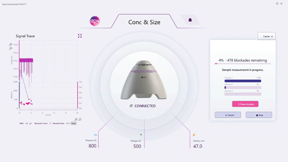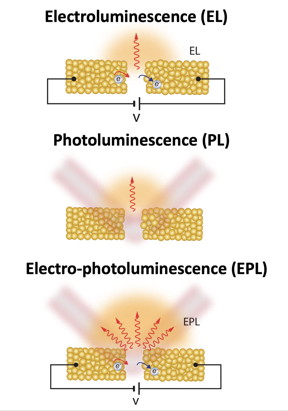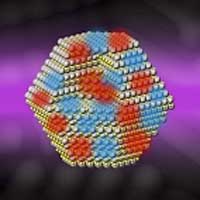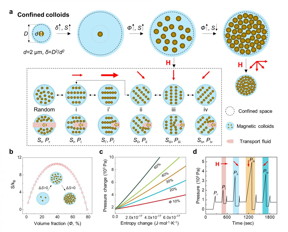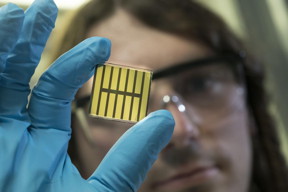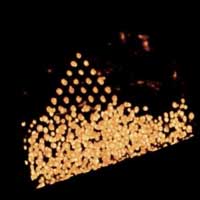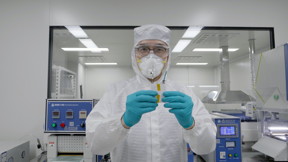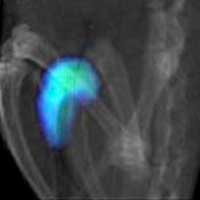Home > Press > Izon Science launches the Exoid to transform nanoparticle measurement: The semi-automated Exoid device uses new-generation Tunable Resistive Pulse Sensing (TRPS) technology, enabling the measurement of complex nano-particle size, concentration, and charge with unparalleled precAbstract:Izon Science Ltd announced the worldwide launch of its latest nanoparticle measurement...
Controlling bubble formation on electrodes
Mar 26, 2021 (Nanowerk News) Using electricity to split water into hydrogen and oxygen can be an effective way to produce clean-burning hydrogen fuel, with further benefits if that electricity is generated from renewable energy sources. But as water-splitting technologies improve, often using porous electrode materials to provide greater surface...
Nanotechnology Now – Press Release: Teamwork makes light shine ever brighter: Combined energy sources return a burst of photons from plasmonic gold nanogaps
Home > Press > Teamwork makes light shine ever brighter: Combined energy sources return a burst of photons from plasmonic gold nanogapsElectrical current and laser light combine at a gold nanogap to prompt a dramatic burst of light. The phenomenon could be useful for nanophotonic switches in computer chips and...
Scientists uncover a process that stands in the way of making quantum dots brighter
Mar 25, 2021 (Nanowerk News) Bright semiconductor nanocrystals known as quantum dots give QLED TV screens their vibrant colors. But attempts to increase the intensity of that light generate heat instead, reducing the dots light-producing efficiency. A new study explains why, and the results have broad implications for developing future...
Nanotechnology Now – Press Release: Confined magnetic colloidal system for controllable fluid transport
Home > Press > Confined magnetic colloidal system for controllable fluid transportSchematics of confined colloids in different states via remote and dynamic magnetic regulation CREDIT ©Science China PressAbstract:Colloidal suspensions of microscopic particles show complex and interesting collective behaviors. In particular, the collective dynamics of colloids is fundamental and ubiquitous...
Planting the seed for DNA nanoconstructs that grow to the micron scale
Mar 22, 2021 (Nanowerk News) A team of nanobiotechnologists at Harvard's Wyss Institute for Biologically Inspired Engineering and the Dana-Farber Cancer Institute (DFCI) led by Wyss Founding Core Faculty member William Shih, Ph.D., has devised a programmable DNA self-assembly strategy that solves the key challenge of robust nucleation control and...
Nanotechnology Now – Press Release: Shedding light on perovskite films: Efficient materials for future solar cells
Home > Press > Shedding light on perovskite films: Efficient materials for future solar cells - New model to determine photoluminescence quantum efficiencyIn terms of efficiency, perovskite solar cells have caught up on silicon solar cells, but some of their properties are not yet understood completely. CREDIT Markus Breig,...
Building tough synthetic nanomaterials with DNA nanotechnology
Mar 19, 2021 (Nanowerk News) Columbia Engineering researchers, working with Brookhaven National Laboratory, report today that they have built designed nanoparticle-based 3D materials that can withstand a vacuum, high temperatures, high pressure, and high radiation. This new fabrication process results in robust and fully engineered nanoscale frameworks that not only...
Nanotechnology Now – Press Release: Graphene nanotubes gain traction in automotive market: OCSiAl confirms compliance with IATF 16949
Home > Press > Graphene nanotubes gain traction in automotive market: OCSiAl confirms compliance with IATF 16949Abstract:OCSiAl has confirmed its graphene nanotube solutions production facility and management system to be compliant with the IATF 16949 standard, paving the way to even wider application of graphene nanotubes in auto industry. Li-ion...
Observing the collective movement of nanorobots in vivo
Mar 17, 2021 (Nanowerk News) Nanobots are machines whose components are at the nano-scale (one millionth of a millimetre), and can be designed in such a way that they have the ability to move autonomously in fluids. Although they are still in the research and development phase, very significant advances...

